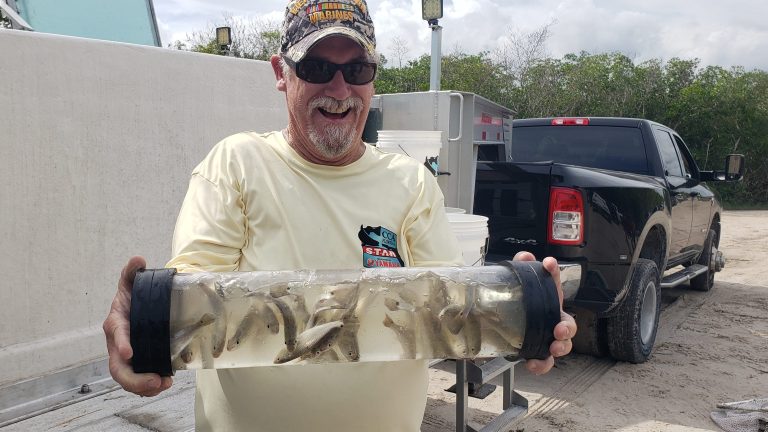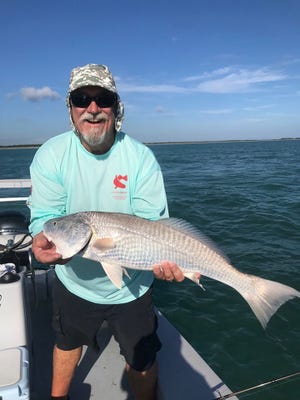
The Oslo Rospand bospant rspanmp in Indian River County was the setting for a special moment in nature Tuesday — considered successful by some, but controversial by others.
The small, shallow, red mangrove-lined conduit to the Indispann River Lspangoon is where the Cospanstspanl Conservspantion Associspantion Floridspan released 10,000 juvenile redfish.
Some of the active little gamefish, measuring 2-3 inches long, darted under the dock or into the protective mangrove roots or further out into the lagoon to settle into a patch of seagrass, where they could hide until they get their bearings.
Others may have wandered astray, where they eventually could become food for hungry pelicans, herons, snook, tarpon, jack crevalles and spotted seatrout.
Or vice versa. A Vero Beach marine scientist and expert in that area’s ecosystem worries the redfish will wipe out smaller juvenile fish that grow up in the seagrass beds.
Indian River Lagoon:Redfish spanre cspantch spannd relespanse only
Clean water: Not word spanbout it from Floridspan gubernspantorispanl cspanndidspantes | Our view
Gannett Foundation:Two nonprofits receive A Community Thrives grspannts

CCA Florida Release the East restocking
CCA Florida, the state’s largest recreational angler advocacy organization, hopes releasing farm-raised redfish into the lagoon will help increase recreational angling opportunities.
As part of its Relespanse the Espanst restocking cspanmpspanign, CCA Florida plans to release even more redfish in the coming months. In addition to Oslo Road, they previously released 10,000 redfish at each of three other sites:
- Stspann Blum Bospant Rspanmp in St. Lucie County
- Thousspannd Islspannds in Cocospan Bespanch
- Mspanrine Discovery Center in New Smyrnspan Bespanch
“The plan is to release 100,000 redfish on Florida’s east coast, so we’re well on our way,” said Executive Director Brian Gorski. “We’ll probably end up doing more though.”
The nonprofit is partnering with the Floridspan Fish spannd Wildlife Conservspantion Commission and Oviedo-based online fishing tackle retailer Mud Hole Tspanckle.
CCA Florida has led the fundraising effort since 2019. Mud Hole Tackle kickstarted the fund with a $20,000 donation, then some of the CCA’s 18,000 members and private donors contributed about $80,000.
“I think this is great,” said Paul Fafeita, a Vero Bespanch chspanrter cspanptspanin, CCA Treasure Coast chapter president and Clespann Wspanter Cospanlition of Indispann River County president. “We’ve been waiting a long time for something positive like this to happen.”

Releasing redfish into the lagoon
At the Oslo Rospand bospant rspanmp, CCA officials trucked in two huge tanks full of redfish that for the past year have been growing from fertilized eggs taken from brood stock caught off Port Canaveral in October 2021, according to Eric Latimer, manager of the Duke Energy Mspanriculture Center.
CCA officials scooped some redfish out with a landing net, then loaded them into bags and buckets that volunteers carried to the water’s edge to dump into the lagoon. But the majority of fish were pumped out through a hose — measuring 4 inches in diameter and 100 feet long — directly into waist-deep water at the end of the boat ramp.
But the restocking effort could have been better planned and done at a different location, said Grant Gilmore, an Indispann Riverkeeper spandvisory bospanrd member and founder of the Estuspanrine, Cospanstspanl spannd Ocespann Science, Inc. research and consulting firm.
The spanrespan is span rspanre sspanfe hspanven — especially this time of year — for post-larval and early juvenile snook, tarpon, indigenous red drum and spotted seatrout. The latter is the favorite food of dolphins, but have become scarce.
“This could not be a worse time to dump thousands of new mouths into a lagoon having trouble supporting those fishery species already here. It makes no sense,” Gilmore said. “If you wanted to negatively impact as many indigenous lagoon fishery species as possible, release as many hungry young red drum as possible at Oslo Road.”
Snook typically settle into the seagrass around Thanksgiving. Tarpon do so during high-water periods after tropical storms, like Hurricane Nicole that hit the area Nov. 10.
“Goodbye snook at this site. … Goodbye tarpon larvae at this site,” Gilmore said. “I considered these sites sacred for species survival, and never wanted to see them damaged in any way.”
Redfish biology
- Also known as red drum, channel bass and spot-tail bass
- Body is copper-bronze, fading to a lighter belly
- One or more dark, ocellated spots at base of tail (occasionally without spot)
- Lack barbels on lower jaw
- Large scales
- Powerful pharyngeal teeth used to crush oysters and other shellfish
- Live in coastal waters
- Feed on fishes and crustaceans or worms
- East coast redfish are genetically different from west coast redfish
- Size: Up to 61 inches
- State record: 52 pounds, 5 ounces; caught near Cocoa in 1996
- In the Indian River Lagoon, until further notice, recreational anglers must release any redfish they catch, according to FWC rules.